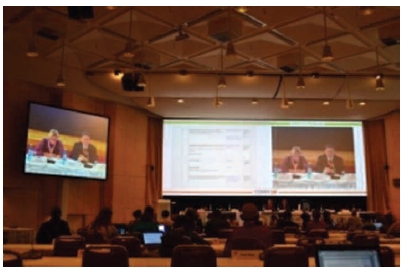Editor’s Note: This article is intended for information purposes only. Because state and municipal laws vary greatly, as do the circumstances of individual cases, readers are advised to contact an attorney for specific legal advice. © Scott C. Tips 2013
Sunset pinked the German sky as the Codex delegates sat at their conference-room tables, a long first day already behind them, still debating health standards that will affect billions worldwide. Naturally a day filled with such debates—especially over technical language for draft guidelines for vitamin-and-mineral Nutrient Reference Values (NRVs) as well as draft Principles about adding essential nutrients to foods—would trick the delegates’ sense of time as they crawled through reams of documents, making a long day seem even longer. At such times, natural health is a frequent casualty because overall vision is sacrificed on the altar of hyper-technicality. But not this time. Instead, this first day of the 35th session of the Codex Committee on Nutrition and Foods for Special Dietary Uses (CCNFSDU) saw health granted a reprieve, however provisional, as the executioners stayed their hands for reasons unknown.
With 263 delegates in attendance—composed of government functionaries and international non-governmental organization (INGOs) representatives—any public observer would be considered a fool by conventional wisdom to think that such assembled intelligence and focused attention could fail to generate solid, scientifically-based food standards and guidelines. Yet all too often, that is exactly what happens.
In the nearly 20 years that the National Health Federation (NHF) has been attending Codex meetings, it has seen ridiculously low upper limits set on dietary supplements, GMO food labeling shot down in defeat, the toxic steroid-like animal drug ractopamine approved for use, a melamine exemption for infant formula barely defeated at the ultimate last minute and some recommended daily intakes for vitamins and minerals set at laughable levels. As a Codex-accredited INGO, NHF participated actively, even aggressively, in all of those battles because the food standards and guidelines adopted by the Codex Alimentarius Commission are then used domestically by numerous countries worldwide and by virtually all countries in international food trade. They are important. So, once again, NHF sent a delegation with me at its head to this latest Codex meeting in Bad Soden, Germany.1
The Word That Scares the Medical World
“Working Groups” are Codex’s way of advancing its various projects more quickly.2 The Working Group at this CCNFSDU meeting assembled on Saturday, November 2; and it worked all day, creating and revising wording within the “General Principles for the Addition of Essential Nutrients to Foods.” Quite typically for Codex, these Principles are rigid, control-freak guidelines as to when, what and how much governments will allow companies to do when adding essential nutrients (read, very safe vitamins and minerals) to foods.
This control-freak attitude can lead to such absurdities as an effort by the EU delegation to strike out the phrase “preventing deficiencies of nutrients” because, according to the EU, it implied diseases would be prevented by nutrients and that would not be proper! The NHF, the International Dairy Federation (IDF), Senegal, Togo, the United States and others promptly spoke up to disagree, with the NHF leading the battle here by insisting that medicine does not have a monopoly on the use of the word “prevention” and that nutrients can and do in fact prevent nutrient deficiencies. Indeed, it would be absurd for Codex to take issue with such a tautological statement as “one of the purposes of adding essential nutrients to food is to prevent deficiencies of those nutrients”!
Even Alcohol Is Scrutinized
Keep in mind that these Principles are simply general guidelines for Codex member states to follow for the addition of essential nutrients to foods. There are no specific nutrients named here, nor “hard” numbers designated for nutrients, to be added to foods.

|
|
| The Working Group meeting, November 2nd |
One incident in particular illustrates the Codex process well. In the general session of CCNFSDU that started two days after the Working Group meeting, the Committee debated whether to retain or delete the following sentence: “Essential nutrients should not be added to alcoholic beverages.” The EU delegate correctly asked that this sentence be deleted because there was no definition of alcoholic beverage. Canada supported the EU, but virtually every delegation after Canada espoused their strong support for keeping this sentence in the Principles because they believed that adding nutrients to alcohol would encourage increased consumption of alcohol to supply nutrient needs. On behalf of NHF, I was the only participant to attack the issue directly when I argued that alcohol consumption is fairly inelastic; that is, people are going to consume alcohol whether we want them to or not (just look at America’s failed experiment with Prohibition in the 1920s) and Codex might as well keep such people healthier by allowing nutrient fortification of alcoholic beverages. This suggestion created a stir among the Codex delegates.
Other concepts were enshrined in the Codex General Principles, such as essential nutrients can only be added to foods up to, but not exceeding, the Upper Level of Intake (but where no Upper Level of Intake has been established, then at levels where it is unlikely to result in an adverse health effect). The NHF unsuccessfully fought for substituting the phrase “serious adverse health effect” in place of “adverse health effect” and was even slighted by the Codex Chairwoman who refused to let the Report reflect that discussion, even though she had permitted far less relevant statements to be inserted into the record. So much for transparency at Codex!
On the plus side, Codex made it clear that nutrients may be added to foods to prevent deficiencies, to reduce the risk of inadequate intake, to meet recommended intakes of those nutrients, to maintain or improve health, and/or to maintain or improve the nutritional quality of foods. That covers a broad range; but, as always at Codex and with regulatory agencies, the interpretation of this mandate will determine the success or failure of nutrient additions to foods.
Nutrient Reference Values
Those who have been following the NHF’s efforts at Codex since the mid-1990s will recall that at the Codex Nutrition Committee meeting in Dusseldorf, Germany in 2009, the NHF singlehandedly launched the opposition that stopped the Australian delegation and others from recklessly lowering these NRVs.3
However, the NHF’s multi-year winning streak in blocking these “dumbed down” NRVs came to an end with last year’s Nutrition Committee meeting in December 2012, where three women (the Chairwoman and the Australian and U.S. delegates) decided to split the vitamins and minerals into two groups: One that was considered “suitable” for adoption; and a second group that was considered “unsuitable” and would need further work.4 The Chairwoman ignored the strong objections of five delegations (Malaysia, Iran, South Africa, the International Dairy Federation and the NHF) to decide that “consensus” existed and the “suitable” list could go to the Commission for approval.5 These nutrients are now labeled as “Batch 1” and “Batch 2.”
Unfortunately, at last July’s Codex Alimentarius Commission meeting, the Commission rubber-stamped the Troika’s Batch 1 NRVs and adopted them as final.6 That left the remaining batch to be dealt with at this year’s CCNFSDU meeting.
However, NHF’s efforts four years ago at this Committee are still bearing fruit as this Committee struggles to establish hard numbers for the vitamin-and-mineral NRVs that remain. Now, Australia and the Chairwoman propose that those vitamins and minerals that must still be considered be split into two additional batches. In this way, they hope to win their way through to “ridiculously low” values that would make even the most drug-happy doctors laugh out loud at the feebleness of them.
That seems to be their strategy: Divide the nutrients into smaller, digestible batches and pass them off piecemeal through the Committee and up to the Commission for final adoption. It certainly worked on Batch 1, as Codex delegates failed to notice that the proposed NRVs offered by Australia and the FAO/WHO were, in the most part, aberrant values greatly at variance with those put out by the Institutes of Medicine, the European Food Safety Authority (EFSA) and other governmental scientific bodies, including those of Australia and New Zealand in some cases! True scientists know that in a batch of data, aberrant data should be greatly distrusted. So, why is Australia always favoring the aberrant data? Something does not smell right and NHF has kept Codex noses pointed in that direction.
At the CCNFSDU meeting just concluded in Bad Soden, Germany, Australia balked at pushing forward its plan to reduce the daily values for vitamins A, C, D and E, as well as magnesium, selenium and zinc. All of a sudden, the big debate on those values has been pushed back to next year’s meeting (and even to the 2015 meeting for vitamins A, D, E, phosphorus, chromium, magnesium, copper and chloride, the now-designated “Batch 3”). More data will be acquired, particularly from EFSA, and the fight over the NRVs for vitamin C, zinc, iron, selenium, manganese, molybdenum and fluoride will occur. Of course, the 2014 meeting will take place in a far corner of the world: Bali, Indonesia. It remains to be seen if some of the “dumbed down” NRVs key opponents can make that distant trip.
The Players
Despite the EU’s one-off, bizarre opposition to Codex including the simple statement that “nutrients prevent nutrient deficiencies” in its General Principles for Nutrient Addition to Foods, the EU head of delegation, Basil Mathioudakis, was consistently hitting the mark throughout the meeting with his many commonsense and beneficial suggestions about the Codex texts. In just one instance alone, he was responsible for deleting wording that would have prohibited “the indiscriminate addition of nutrients to foods.” NHF verbally supported this deletion for obvious reasons, as did a number of other delegations who coalesced around the EU to eliminate this useless wording.
A pleasant surprise at this meeting came in the form of the new head of the U.S. delegation, Paula Trumbo, who also took the floor many times with very pro-health positions. The United States, for example, came out strongly in support of preserving the “nutrients prevent nutrient deficiencies” statement in the Codex General Principles when others were on the verge of eliminating the statement. Trumbo’s pleasant and open demeanor also contrasted favorably with that of her predecessor in the Committee, giving a softer edge to a country that is all too often seen as nothing more than a bully on the World stage.
Australia’s Janine Lewis was, well, Janine Lewis—myopically focused on hyper-technicalities and oblivious to the flotsam of death and disease that follow in her wake. The NHF’s and others’ recent campaign in Australia to rein in the ardently anti-health agenda of Australia’s Codex Office7 might have contributed to Australia’s less gung-ho attitude to advance the second round of “ridiculous” vitamin-and-mineral NRVs at this meeting, but we may never know. Still, pressure must be maintained to curb this rogue food agency’s anti-health excesses.
Dr. Pia Noble, the German Codex Chairwoman and the “Thelma” to Lewis’ “Louise,” must take her marching orders from the same anti-health shadow figures as does Lewis. One can only imagine; and, yet, it seems strange that both the Chairwoman and the Australian delegate came up with the timetable and “batch” arrangement for the vitamin-and-mineral NRVs ex Imperium and then simply presented them to the Committee as a fait accompli for it to rubber stamp.
Senegal’s Dr. Sall of the University of Dakar was an amazing pillar of strength and clarity, who showed no fear in presenting and standing by his strongly pro-health positions throughout the Codex meeting. Dr. Sall’s calls for optimal health in Codex standards tracked NHF’s own steady emphasis over the years on optimizing health for consumers. In that respect, other delegates such as Iran, Togo and South Africa also spoke out for better health standards. And the International Dairy Federation continued its tradition of speaking with integrity in considering the health of its customers and the interests of its dairy-farmer members. So, fortunately for the World, Codex is not without its health heroes.
For Now
Fortunately, the ridiculous NRVs were delayed by another year so that they could not slip through the Committee as the previous batch of NRVs had done. Fortunately, too, many members of the Committee are awakening to the fact that the NRVs being pushed by Australia are not in the best interests of consumers, nor will they work to best protect the public health.
The outcry must continue against this push to saddle us all with  Codex standards of ill-health. If enough of us challenge this—shall we say it charitably?—nutritional ignorance, then we shall prevail and preserve another patch of health for ourselves and our children. WF
Codex standards of ill-health. If enough of us challenge this—shall we say it charitably?—nutritional ignorance, then we shall prevail and preserve another patch of health for ourselves and our children. WF
A graduate of the University of California at Berkeley Law School, Scott C. Tips currently practices internationally, emphasizing Food-and-Drug law, business law and business litigation, trade practice, and international corporate formation and management. He has been involved in the nutrition field for more than three decades and may be reached at (415) 244-1813 or by e-mail at scott@rivieramail.com.
End Notes
1. The National Health Federation delegation consisted of Scott Tips, Dr. Uwe Alschner and Katherine A. Carroll. The NHF-Germany Executive Director, Petra Weiss, took ill and could not attend this year. Bill Sardi and Scott Tips drafted the NHF’s submission paper arguing for higher levels of NRVs, while Katherine Carroll, Jonathan Middleton and Gray Graham drafted the NHF submission paper arguing for the retention in infant formula of the full Vitamin-E complex. These NHF papers were published by the German Codex Secretariat as Conference Room Documents 4 and 18 (CRD 4 & CRD 18), respectively, and made available to all of the CCNFSDU delegates at the meeting. They can be found online at www.thenhf.com/codex.
2. The Working Groups meet electronically (by e-mail exchanges amongst members) and/or physically (in person).
3. Australia and its supporters had wrongly proposed that lower NRVs be adopted for certain important vitamins and minerals, including vitamin C. For example, the Proposed Draft Additional or Revised NRVs for Labelling Purposes in the Codex Guidelines on Nutrition Labelling suggested reducing the vitamin A NRV from 800 micrograms down to 550 micrograms, vitamin C from an already-abysmally-low 60 milligrams down to 45 milligrams, thiamin from 1.4 milligrams down to 1.2 milligrams, niacin from 18 milligrams down to 15 milligrams, magnesium from 300 milligrams down to 240 milligrams, and so forth.
4. See CCNFSDU document number CX/NFSDU 12/34/8. The suitable batch included the B vitamins and calcium, with all NRVs reduced except for folate and calcium.
5. Note that in 2009, CCNFSDU Chairman Grossklaus had found a lack of consensus with only four delegations opposed, as compared with five here.
6. See Scott Tips’ article, “Brave Benin” at www.thenhf.com/
article.php?id=3653.
7. See Scott Tips’ article, “The Great Australian Health Mystery” at www.thenhf.com/article.php?id=3654. See also Eve Hillary’s excellent take-action letter to Ms. Lewis at www.sarahs-last-wish.com/Taking-Action.html.
Published in WholeFoods Magazine, December 2013










